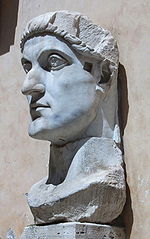Battle of Chrysopolis
| Battle of Chrysopolis | |||||||
|---|---|---|---|---|---|---|---|
| Part of the civil wars of the Tetrarchy | |||||||
 Constantine – head from a colossal sculpture, Rome |
|||||||
|
|||||||
| Belligerents | |||||||
| Constantine I | Licinius | ||||||
The Battle of Chrysopolis was fought on 18 September 324 at Chrysopolis (modern Üsküdar), near Chalcedon (modern Kadıköy), between the two Roman emperors Constantine I and Licinius. The battle was the final encounter between the two emperors. After his navy's defeat in the Battle of the Hellespont, Licinius withdrew his forces from the city of Byzantium across the Bosporus to Chalcedon in Bithynia. Constantine followed, and won the subsequent battle. This left Constantine as the sole emperor, ending the period of the Tetrarchy.
In the Battle of the Hellespont Licinius' navy had suffered a catastrophic defeat. His admiral, Abantus, had been outfought by Constantine's son the caesar Crispus, despite the latter's distinctly smaller fleet. Following this naval victory, Constantine crossed over to Asia Minor. He used a flotilla of light transports he had ordered to be built on the Bosporus in order to avoid the enemy army, which, under the command of Licinius' newly appointed co-emperor Martinian, was guarding the coast at Lampsacus on the Hellespont. Following the destruction of his naval forces Licinius evacuated the garrison of Byzantium, which joined his main army in Chalcedon on the Asiatic shore of the Bosporus. From there he also summoned Martinian's forces and a band of Visigothic auxiliaries, under their leader Aliquaca (or Alica), to reinforce his principal army which had been depleted by its earlier defeat at the Battle of Adrianople. It is not clear whether Martinian's forces reached Licinius before September 18 when Licinius was brought to battle by Constantine.
...
Wikipedia
